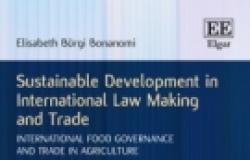Book Review - Sustainable Development in International Law Making and Trade: International Food Governance and Trade in Agriculture

Sustainable Development in International Law Making and Trade: International Food Governance and Trade in Agriculture by Elisabeth Bürgi Bonanomi. Cheltenham: Edward Elgar Publishing, 2015. 428 pp., £105 hardcover 978-1-78471-726-1, £30 e-book 978-1-78471-727-8
The book “Sustainable Development in International Law Making and Trade” by Elisabeth Bürgi Bonanomi was published in 2015, the same year that the international community adopted the sustainable development goals. The book operationalizes and provides legal normativity to the concept of sustainable development. It promotes sustainable development as a legally binding principle that is precise enough not only to guide the interpretation of law, but also to provide guidance to the development of new norms. By developing a nuanced and convincing approach to the institutionalization and normativity of sustainable development in international law and by giving not only abstract and theoretical but also concrete and operational content to the principle, sustainable development becomes more than a concept of political discourse: it becomes a multidimensional legal principle and methodical norm for coherent law making.
The book is structured in three parts: the first part (chapters 1-2) explores the foundations of sustainable development; the second part (chapters 3-5) discusses sustainable development as a concept of international law and as a normative framework for coherent decision making; the final part of the book (chapters 6-7) assesses the theory developed in the previous parts in the light of the WTO Agreement on Agriculture.
Chapter 1 outlines the origins and the evolution of sustainable development. It argues that the concept of sustainable development reconciled the sectorial approaches towards development which had shaped the discourse form 1969 to 1990. Chapter 2 reflects upon conceptual and institutional approaches to sustainable development. It describes the multi-dimensional conception of sustainable development; argues that the magic triangle of society, environment and economy neglects important dimensions such as human rights, culture or enabling institutions; and promotes a non-hierarchical approach that integrates and reconciles the various dimensions of sustainable development. After discussing the capital stock model of the World Bank, context-based approaches, people-centred perspectives, and the economic dimension of sustainable development, Bürgi presents efforts to mainstream sustainable development at the national and international level through national sustainable development strategies, through the inclusive policy making approach developed by the OECD, and through informed decision making based on impact assessments. The first part concludes by arguing that “sustainable development is much about the search for an ‘optimal’, well balanced solution, implying that synergies and inherent conflicts are equally identified” (p. 95), that “inclusive decision making requires that all related and involved legal interests are seriously taken into account when developing regulatory options” (p. 96), that “sustainable development includes both substantive and procedural elements” (p. 97), and that “adequate framing of decision making procedures must be placed centre stage in order to ensure optimal handling of complexity” (p. 96). Chapter 3 analyses how treaty law, international jurisprudence and academia refer to sustainable development and argues that a legal principle of sustainable development with clear normative shapes can be affirmed. Bürgi develops a multi-dimensional framework of sustainable and coherent law making which allows “the feeding into the policy process of a range of optimal options which would otherwise not have been tabled” (p. 99). Based on the work of Gehne, Bürgi proposes a framework for law making that seeks to reconcile the competing interests that cohabit within the concept of sustainable development, offering an original methodology to accommodate them into a single coherent approach. She presents three duties that sustainable development requires for the development of new norms: 1) the duty to include, 2) the duty to structure and weigh, and 3) the duty to balance and reconcile by developing optimal options. The first duty “reflects the imperative that all legal standards upon which the decision may directly or indirectly impact must be taken into account” (p. 137) which requires the development of a “carpet of relevant targets” (p. 139). Based on these three duties, Bürgi develops “a framework of sustainable, informed and inclusive decision making” (p. 155) with the following steps: 1. inclusion; 2. structuring; 3. weighting; 4. optimizing, including through ex ante sustainability impact assessments; 5. policy choice; 6. monitoring, including through ex post sustainability impact assessments; and 7. anticipating. Bürgi concludes chapter 3 by arguing that “the concept of sustainable development is not only a political concept, but also a legal principle with concrete legal contours. It constitutes a methodological norm combining both procedural and substantive elements. Thereby, the three related duties – the duty to include; the duty to structure and weigh; and the duty to balance and reconcile by developing optimal options – are sufficiently concrete for legal implementation and judicial review” (p. 156).
Chapter 3 analyses how treaty law, international jurisprudence and academia refer to sustainable development and argues that a legal principle of sustainable development with clear normative shapes can be affirmed. Bürgi develops a multi-dimensional framework of sustainable and coherent law making which allows “the feeding into the policy process of a range of optimal options which would otherwise not have been tabled” (p. 99). Based on the work of Gehne, Bürgi proposes a framework for law making that seeks to reconcile the competing interests that cohabit within the concept of sustainable development, offering an original methodology to accommodate them into a single coherent approach. She presents three duties that sustainable development requires for the development of new norms: 1) the duty to include, 2) the duty to structure and weigh, and 3) the duty to balance and reconcile by developing optimal options. The first duty “reflects the imperative that all legal standards upon which the decision may directly or indirectly impact must be taken into account” (p. 137) which requires the development of a “carpet of relevant targets” (p. 139). Based on these three duties, Bürgi develops “a framework of sustainable, informed and inclusive decision making” (p. 155) with the following steps: 1. inclusion; 2. structuring; 3. weighting; 4. optimizing, including through ex ante sustainability impact assessments; 5. policy choice; 6. monitoring, including through ex post sustainability impact assessments; and 7. anticipating. Bürgi concludes chapter 3 by arguing that “the concept of sustainable development is not only a political concept, but also a legal principle with concrete legal contours. It constitutes a methodological norm combining both procedural and substantive elements. Thereby, the three related duties – the duty to include; the duty to structure and weigh; and the duty to balance and reconcile by developing optimal options – are sufficiently concrete for legal implementation and judicial review” (p. 156).
In Chapter 4, Bürgi argues “that only those legal settings which comply with both the criteria of formal and substantive coherence constitute an optimal option” (p. 158), and she therefore promotes sustainable development also as a normative framework for coherent decision making. Chapter 5 then examines the status of sustainable development in international law, highlighting its guiding, procedural normative elements and concluding that “the concept of sustainable development comes with recommendatory strength” (p. 193).
Chapter 6 presents the WTO Agreement on Agriculture and confronts the constitutional principles of the WTO with the principle of sustainable development. Chapter 7 finally applies the legal principle of sustainable development and the three duties to the WTO Agreement on Agriculture, looking at the objectives of the agreement, and potential ‘optimal’ enabling agricultural trade frameworks which promote the identified objectives.
The book particularly focuses on questions related to coherent law making. It examines how law making processes could be shaped in order to arrive at coherent – and thus sustainable – outcomes. Stiff policy debates should be de-constructed and conflicts should be brought to the table for new perspectives on alternative policy options. The literature on sustainable development has for a long time focused on the interpretation of international law and by-passed international law-making. While many have understood the concept of sustainable development merely as a political concept, Bürgi argues that it is itself a principle of law with guiding force especially for the process of developing new norms, and that “[t]he use of the concept of sustainable development as a guiding, overarching concept for policy making is, in itself, a major achievement” (p. 2). She concludes that the framework of sustainable, informed and inclusive decision making “allows for structuring the law making process in a way which ensures that it has not lost sight of the whole picture, that the hidden conflicts are tabled and that the search for most optimal coherent options is made” (p. 362). While the different duties and steps for sustainable norm making developed by Bürgi are convincing, the reality – especially in the political processes of international negotiations or of parliaments – may not always be as conducive to operationalize these duties, steps and concepts. Nevertheless: the reflections of Bürgi are stimulating and most helpful, and by “activating the normative potential of sustainable development” (p. 1) in the area of law making, the book clearly addresses a gap in legal literature.
Dr. Franz Perrez is lecturer of international environmental law at the University of Bern, School of Law, and Switzerland’s Ambassador for the Environment.

